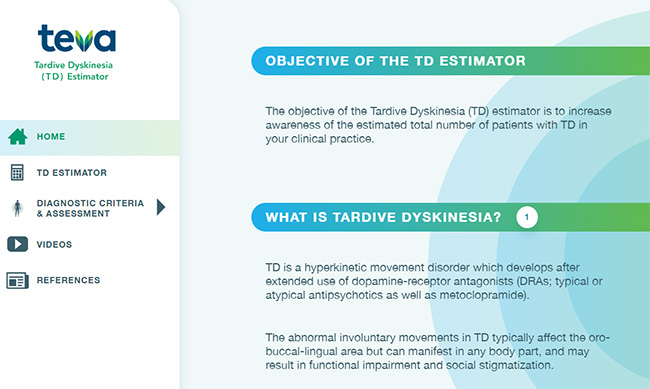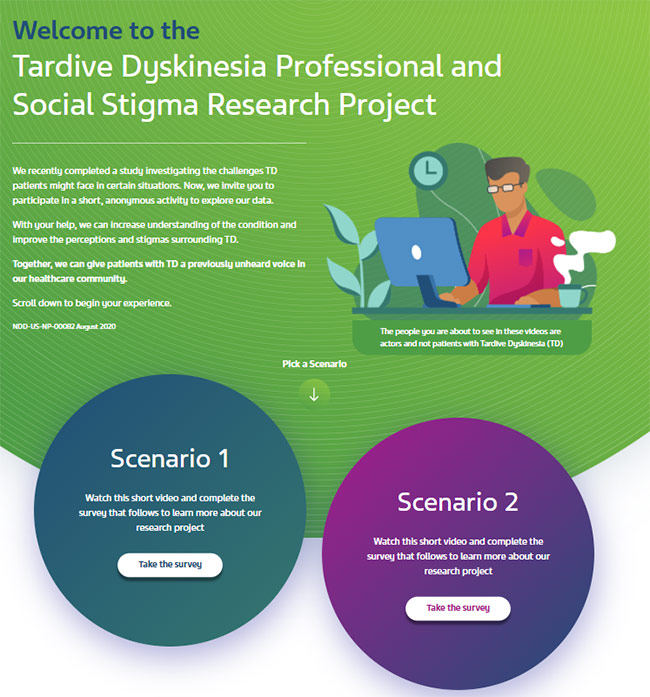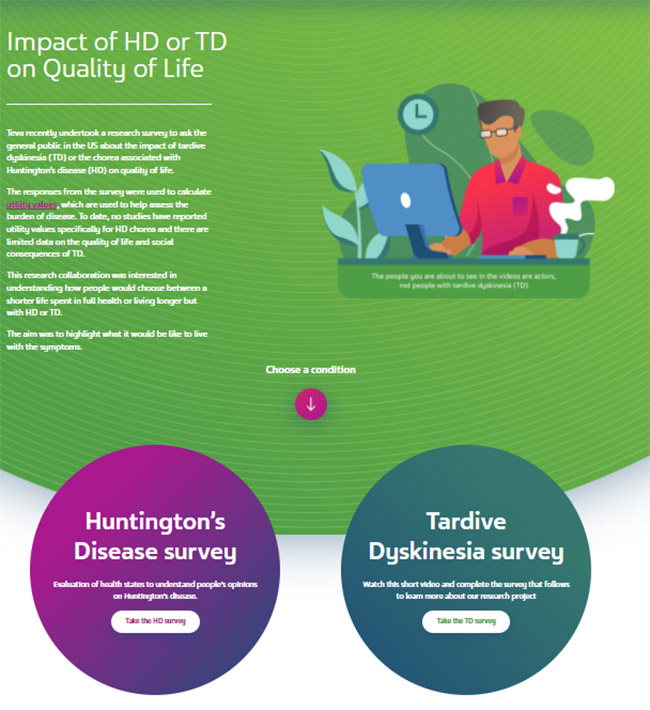
Explore our interactive tools to uncover more about the impact and epidemiology of movement disorders
Under-recognition, misdiagnosis, and undertreatment of movement disorders including Huntington’s disease chorea and tardive dyskinesia have a profound effect on patients’ lives.1–3 Read the article below to understand what it is like to live with these conditions, and how to access three interactive tools developed for use in your clinic.
The lesser-known movement disorders Huntington’s disease (HD) and tardive dyskinesia (TD) are under-recognized and frequently misdiagnosed,1,2 despite collectively affecting around 600,000 people in the USA.3,4 While FDA-approved medications are available to treat symptoms of HD chorea and TD,5–7 failure to accurately diagnose these conditions delays patients from receiving appropriate treatment.
Estimating TD in clinic
To increase awareness of TD in clinical practice, the ‘TD estimator’ has been developed. By answering just four questions on antipsychotic drug use (number of patients using typical antipsychotics, number of patients using atypical antipsychotics, percentage of patients on atypical antipsychotics with no prior history of typical antipsychotics, and percentage of patients on atypical antipsychotics with an unknown drug history), this application can gauge how many patients are at risk of TD in your practice. The estimates of the prevalence of TD as a result of exposure to typical and atypical antipsychotics are based on published literature.8 The tool also houses information on TD assessment and diagnosis, including the DSM-5 and Schooler–Kane diagnostic criteria, and provides an overview of the AIMS. Patient videos help guide you on what to look for during patient assessments.
You can try the TD estimator here.

The stigma of movement disorders
Even after diagnosis, HD is often undertreated. A 2016 survey, conducted by the Huntington’s Disease Society of America, reported that 40% of respondents were unaware of, or not utilizing, any medication to treat their chorea.9 Similarly, only 53% of 200 neurologists in the USA reported treating patients with severe chorea (2018 online survey).10 This undertreatment may be due to a lack of awareness of the burden surrounding HD chorea and TD.
Patients with TD often feel uncomfortable in their own skin,3 and feelings of unacceptance and stigma may arise from discrimination by others.11 While discriminating against someone with TD seems unthinkable, a 2019 study evaluating the orofacial impact of TD symptoms on patients’ professional and social lives showed how the same actors were perceived more negatively when simulating TD movements versus without the movements.11 Significantly fewer respondents said they would like to continue talking to the actor simulating TD movements versus the same actor without the movements (27.5% versus 52.5%, respectively).11 To raise awareness of stigma around this condition, the ‘TD professional and social stigma survey’ has been made available online.

Living with HD and TD
To gain a better understanding of how many years of life individuals are willing to sacrifice to live in full health rather than living with HD or TD, two further surveys were conducted in 2021.12,13 The aim of the surveys was to understand people’s perceptions of living with HD or TD, and to bring attention to the reality of living with these conditions. After being shown a scenario depicting life with this condition, respondents were willing to give up an average of 4.1 years of a 10 year lifespan to avoid living with TD. When shown a scenario of life with severe HD chorea, respondents were willing to give up an average of 9.3 years out of a 10 year lifespan.
Explore how your preferences match those of the survey respondents by trying the online survey here.

Hauser RA, Meyer JM, Factor SA, et al. Differentiating tardive dyskinesia: a video based review of antipsychotic induced movement disorders in clinical practice. CNS Spectr 2020;1–10.
Hansen TE, Brown WL, Weigel RM, et al. Under-recognition of tardive dyskinesia and drug induced Parkinsonism by psychiatric residents. Gen Hosp Psych 1992;14:340–344.
Dhir A, Schilling T, Abler V, et al. Estimation of epidemiology of tardive dyskinesia incidence and prevalence in the United States. Presented at the American Academy of Neurology 2017 Annual Meeting. April 22–28, 2017, Boston, Massachusetts, USA; Poster 2.018.
Yohrling G, Raimundo K, Crowell V, et al. Prevalence of Huntington’s disease in the US. Neurology 2020;94(15 Supplement):954.
Teva Pharmaceuticals. Austedo® (deutetrabenazine) tablets for oral use. Prescribing information; 2020.
Neurocrine Biosciences. Ingrezza® (valbenazine) capsules for oral use. Prescribing information; 2021.
Valeant Pharmaceuticals. Xenazine® (tetrabenazine) tables for oral use. Prescribing information; 2017.
Carbon M, Hsieh CH, Kane JM, et al. Tardive dyskinesia prevalence in the period of second generation antipsychotic use: a meta-analysis. J Clin Psychiatry 2017;78(3):e264–e278.
Simpson JA, Lovecky D, Kogan J, et al. Survey of the Huntington’s disease patient and caregiver community reveals most impactful symptoms and treatment needs. J Huntingtons Dis 2016;5:395–403.
Sung VW, Iyer RG, Gandhi SK, et al. Physician perceptions of pharmacologic treatment options for chorea associated with Huntington disease in the United States. Curr Med Res Opin 2018;34:643–648.
Ayyagari R, Goldschmidt D, Mu F, et al. An experimental study to assess the professional and social consequences of tardive dyskinesia. Presented at Psych Congress 2019; October 3–6, 2019, San Diego, California, USA; Poster 116.
Classen D, Goldschmidt D, Zhou M, et al. Defining utility values for chorea health states in patients with Huntington’s disease. Presented at the American Academy of Neurology (AAN) 2021 Virtual Annual Meeting; April 17–22, 2021.
Ayyagari R, Caroff SN, Goldschmidt D, et al. Defining utility values for patients with tardive dyskinesia. Presented at the 20th World Psychiatric Association (WPA) World Congress of Psychiatry Virtual Congress; 10–13 March 2021.